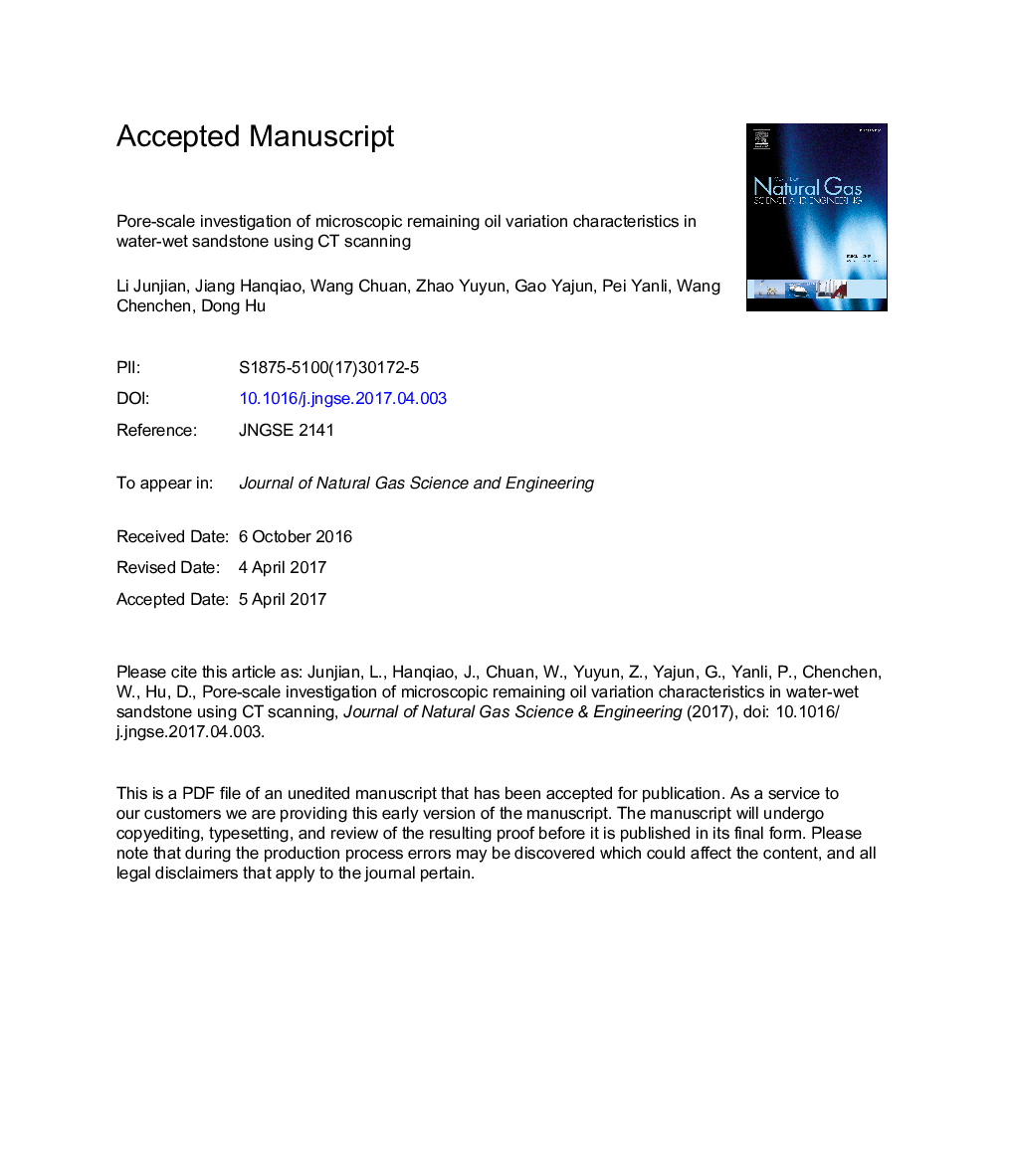| کد مقاله | کد نشریه | سال انتشار | مقاله انگلیسی | نسخه تمام متن |
|---|---|---|---|---|
| 8128478 | 1522995 | 2017 | 18 صفحه PDF | دانلود رایگان |
عنوان انگلیسی مقاله ISI
Pore-scale investigation of microscopic remaining oil variation characteristics in water-wet sandstone using CT scanning
ترجمه فارسی عنوان
بررسی مقیاس پوسته در خصوص ویژگی های تغییرات باقی مانده روغن میکروسکوپی در ماسه سنگ های آبی با استفاده از سی تی اسکن
دانلود مقاله + سفارش ترجمه
دانلود مقاله ISI انگلیسی
رایگان برای ایرانیان
کلمات کلیدی
ترجمه چکیده
با استفاده از تکنیک های پردازش تصویر و سی تی اسکن، آزمایشات نفتی جابجایی آب برای تجزیه و تحلیل شش هسته طبیعی ماسه سنگ خرد شده با نفوذ پذیری و تخلخل مختلف به صورت بصری و کمی انجام شد. روغن باقی مانده از میکروسکوپیک بر اساس پارامترهای مشخصه کمی، از قبیل عامل شکل، نسبت تماس، تعداد اویلر و غیره طبقه بندی شده است. خصوصیات باقیمانده روغن با انواع جریانهای مختلف در مراحل مختلف جابجایی آب ارائه شده است. نتایج تجربی نشان می دهد که روغن باقیمانده را می توان به پنج دسته تقسیم کرد. آنها به ترتیب جریان غشایی، جریان قطره، جریان ستونی، جریان متخلخل و جریان خوشه ای از سخت به تولید و آسان تولید می باشد. نفوذپذیری نسبی فاز نفتی نشان دهنده نفوذپذیری نسبی کل متوسط در تمام رژیمهای جریان 5 بالا است. در میان آنها، جریان خوشه ای دارای ظرفیت تولید قوی و نفوذ پذیری نسبی بالا است و چهار رژیم جریان دیگر ظرفیت تولید ضعیف تر و نفوذ پذیری نسبی پایین تر دارند. تغییرات تعداد و حجم متوسط پنج نوع نفت باقی مانده و چندین اندازه از توزیع اندازه گانگلیون در ادبیات انجام شده است. نقطه ی غیرخطی زانو بر روی منحنی نسبت نفوذپذیری رابطه ای به طور ذاتی ناشی از کاهش حجم و مقدار کسر جریان جریان خوشه ای در هنگام افزایش اشباع آب است. در این مقاله، قانون جریان روغن باقیمانده میکروسکوپی مورد مطالعه قرار گرفته است، سازوکار ذاتی برای ظهور نقطه انفکاکی بر منحنی نسبت نفوذپذیری نسبتی و پدیده جابجایی میکروسکوپی را توضیح داده، و همچنین یک روش موثر پیشرفته ارتقاء تا حد معینی ارائه کرد.
موضوعات مرتبط
مهندسی و علوم پایه
علوم زمین و سیارات
علوم زمین و سیاره ای (عمومی)
چکیده انگلیسی
With the aid of CT scanning and image processing techniques, water displacing oil experiments were performed to analyze six natural water-wet sandstone cores of different permeability and porosity visually and quantitatively. Microscopic remaining oil was categorized on the basis of quantitative characterization parameters, such as shape factor, contact ratio, Euler number etc. The remaining oil characteristics with different flow types were presented in different water displacement stages. Experimental results show that the remaining oil can be divided into five categories. They are, respectively membranous flow, droplet flow, columnar flow, multi-porous flow and clustered flow from hard-to-produce to easy-to-produce. The relative permeability of oil phase is represented by the macro-average relative permeability of all the above five flow regimes. Among them, clustered flow possesses strong producing capacity and high relative permeability, and the other four flow regimes have weaker producing capacity and lower relative permeability. Variation of number and average volume of five types remaining oil and several measurements of the ganglion size distribution have been performed in the literature. The nonlinear knee point on the relative permeability ratio curve is intrinsically caused by the decreasing of volume and quantity fraction of clustered flow when water saturation increases. This paper has studied the flowing law of microscopic remaining oil, explained the intrinsic mechanism for the appearance of an inflection point on the relative permeability ratio curve and microscopic sweep phenomena, and also presented a new effective way of upscaling to a certain extent.
ناشر
Database: Elsevier - ScienceDirect (ساینس دایرکت)
Journal: Journal of Natural Gas Science and Engineering - Volume 48, December 2017, Pages 36-45
Journal: Journal of Natural Gas Science and Engineering - Volume 48, December 2017, Pages 36-45
نویسندگان
Junjian Li, Hanqiao Jiang, Chuan Wang, Yuyun Zhao, Yajun Gao, Yanli Pei, Chenchen Wang, Hu Dong,
